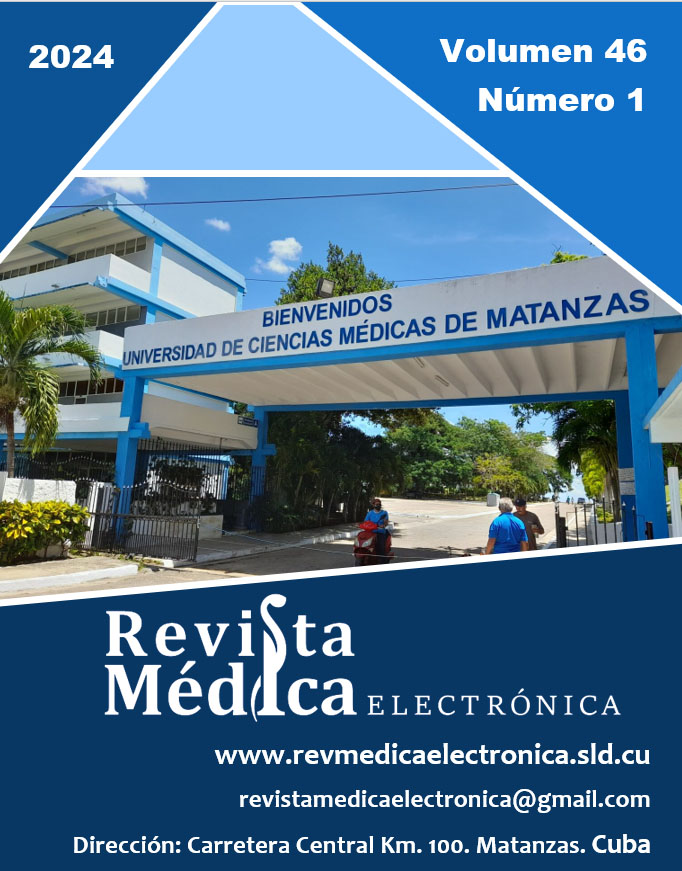Artificial intelligence and automation in health. Criteria of university professors on advances, applications and challenges
Keywords:
artificial intelligence, automation in healthAbstract
Introduction: Automation processes in health do not escape the scope and limitations of artificial intelligence, it is important to know the criteria of university professors regarding the automation of related processes, which may have positive implications in study programs, and their subsequent implementation.
Objective: To analyze criteria of university professors from the Medicine and Software Engineering courses at the Higher Polytechnic School of Chimborazo on the advances, applications and challenges of artificial intelligence in automation in health.
Methods: Descriptive, explanatory research of correlational order, surveying a representative sample of university professors of Medicine (n=61), and Software Engineering (n=38), taking into account the criteria on the importance of seven variables linked to advances, applications and challenges in the use of artificial intelligence in automation in health.
Results: The best values were in the automation of administrative tasks, in favor of Software Engineering (4.26-Good), and Medicine (3.38-Regular); the challenges and ethical considerations in both independent groups presented high quantitative values (>4 points). There is a low agreement between the Medicine teachers (k=0.475), and an acceptable one in Software Engineering (k=0.627), while there are significant differences between independent groups, in the automation of diagnoses (p=0.000), in the automation of administrative tasks (p=0.000), and in automation in customer service and support (p=0.000).
Conclusions: Software Engineering has a better perception of the use of artificial intelligence in health automation. Postgraduate improvement courses are recommended, modifying subjects that include the topics studied.
Downloads
References
2. Bhardwaj A, Kishore S, Pandey DK. Artificial intelligence in biological sciences. Life. 2022;12(9):1430. DOI: 10.3390/life12091430.
3. Ashique S, Mishra N, Mohanto S, et al. Application of artificial intelligence (AI) to control COVID-19 pandemic: Current status and future prospects. Heliyon. 2024;10(4):e25754. DOI: 10.1016/j.heliyon.2024.e25754.
4. Bohr A, Memarzadeh K. The rise of artificial intelligence in healthcare applications. In: Bohr A, Memarzadeh K. Artificial Intelligence in healthcare. Massachusetts: Academic Press; 2020. DOI: 10.1016/B978-0-12-818438-7.00002-2.
5. Zhang J, Su Q, Loudon WG, et al. Breathing signature as vitality score index created by exercises of qigong: implications of artificial intelligence tools used in traditional Chinese medicine. Journal of functional morphology and kinesiology. 2019;4(4):71. DOI: 10.3390/jfmk4040071.
6. Bermúdez-Tamayo C, Jiménez-Pernet J. Inteligencia artificial para el avance de los sistemas de salud. Posibles aportes y retos. Laborum [Internet]. 2022 [citado 12/02/2024];(4):401-14. Disponible en: https://dialnet.unirioja.es/servlet/articulo?codigo=8733022
7. Subramanian M, Wojtusciszyn A, Favre L, et al. Precision medicine in the era of artificial intelligence: implications in chronic disease management. J Transl Med. 2020;18(1):472. DOI: 10.1186/s12967-020-02658-5.
8. Alruwaili FF. Artificial intelligence and multi agent based distributed ledger system for better privacy and security of electronic healthcare records. PeerJ Computer Science. 2020;6:e323. DOI: 10.7717/peerj-cs.323.
9. Shaik T, Tao X, Higgins N, et al. Remote patient monitoring using artificial intelligence: Current state, applications, and challenges. WIREs. 2023;13(2):e1485. DOI: 10.1002/widm.1485.
10. Dos Santos ÁO, da Silva ES, Couto LM, et al. The use of artificial intelligence for automating or semi-automating biomedical literature analyses: A scoping review. Journal of Biomedical Informatics. 2023;142:104389. DOI: 10.1016/j.jbi.2023.104389.
11. Abbas K, Afaq M, Ahmed Khan T, et al. A blockchain and machine learning-based drug supply chain management and recommendation system for smart pharmaceutical industry. Electronics. 2020;9(5):852. DOI: 10.3390/electronics9050852.
12. Xu L, Sanders L, Li K, et al. Chatbot for health care and oncology applications using artificial intelligence and machine learning: systematic review. JMIR cancer. 2021;7(4):e27850. DOI: 10.2196/27850.
13. Naik N, Hameed BM, Shetty DK, et al. Legal and ethical consideration in artificial intelligence in healthcare: who takes responsibility? Front Surg. 2022;9. DOI: 10.3389/fsurg.2022.862322.
14. Sagarra-Romero L, Ruidiaz Peña M, Monroy Antón A, et al. ithlete Heart Rate Variability app: knowing when to train. British Journal of Sports Medicine. 2017;51(18):1373-4. DOI: 10.1136/bjsports-2016-097303.
15. Rodríguez Á, Páez-Granja R, Altamirano-Vaca E, et al. Nuevas perspectivas educativas orientadas a la promoción de la salud. Educ Méd Super [Internet]. 2018 [citado 12/02/2024];31(4). Disponible en: https://ems.sld.cu/index.php/ems/article/view/1366
16. Rodríguez-Torres Á, Naranjo-Munive J, Merino-Alberca W, et al. Adaptaciones curriculares en la enseñanza para alumnos con problemas respiratorios. Rev Cubana Med Gen Integ[Internet]. 2017 [citado 12/02/2024];36(4). Disponible en: http://www.revmgi.sld.cu/index.php/mgi/article/view/717/167
17. Almeida-Campos S. La ciencia abierta y la inteligencia artificial en la Revista Médica Electrónica. Rev Méd Electrón [Internet]. 2024 [citado 12/02/2024];46:e5498. Disponible en: https://revmedicaelectronica.sld.cu/index.php/rme/article/view/5498/5750
18. Sanabria Navarro JR, Niebles Núñez WA, Silveira Pérez Y. Bibliometric analysis of artificial intelligence in sport. Retos. 2024;54:312-9. DOI: 10.47197/retos.v54.103531.
19. Calero-Morales S, Vinueza-Burgos GD, Yance-Carvajal CL, et al. Gross Motor Development in Preschoolers through Conductivist and Constructivist Physical Recreational Activities: Comparative Research. Sports. 2023;11(3):61. DOI: 10.3390/sports11030061.
20. Concepción Obregón T, Fernández Lorenzo A, Matos Rodríguez A, et al. Habilidades profesionales de intervención clínica según modo de actuación de estudiantes de tercer año de Estomatología. Educ Méd Super [Internet]. 2016 [citado 13/02/2024];31(1). Disponible en: https://ems.sld.cu/index.php/ems/article/view/941/0
21. Fernández-Lorenzo A, Pérez-Rico C, Méndez-Rojas V, et al. El marketing social y su influencia en la solución de problemas de salud. Rev Cubana Inv Bioméd [Internet]. 2017 [citado 13/02/2024];36(3). Disponible en: https://revibiomedica.sld.cu/index.php/ibi/article/view/79
22. Sagarra-Romero L, Ruidiaz M, Calero Morales S, et al. Influence of an exercise program on blood immune function in women with breast cancer. Medicina Dello Sport [Internet]. 2018 [citado 13/02/2024];71(4). Disponible en: https://www.minervamedica.it/en/journals/medicina-dello-sport/article.php?cod=R26Y2018N04A0604
23. Mikkili I, Karlapudi AP, Venkateswarulu TC, et al. Potential of artificial intelligence to accelerate diagnosis and drug discovery for COVID-19. PeerJ. 2021;9:e12073. DOI: 10.7717/peerj.12073.
24. Al Mutair A, Al Mutairi A, Ambani Z, et al. The impact of COVID-19 pandemic on the level of depression among health care workers: cross-sectional study. PeerJ. 2021;9:e11469. DOI: 10.7717/peerj.11469.
25. Chow PS. Ghost in the (Hollywood) machine: Emergent applications of artificial intelligence in the film industry. NECSUS. 2020;9(1):193-214. DOI: 10.25969/mediarep/14307.
Downloads
Published
How to Cite
Issue
Section
License
All content published in this journal is Open Access, distributed under the terms of the CC BY-NC 4.0 License.
It allows:
- Copy and redistribute published material in any medium or format.
- Adapt the content.
This will be done under the following terms:
- Attribute the authors' credits and indicate whether changes were made, in which case it must be in a reasonable way.
- Non-commercial use.
- Recognize the journal where it is published.
The copyrights of each article are maintained, without restrictions.






